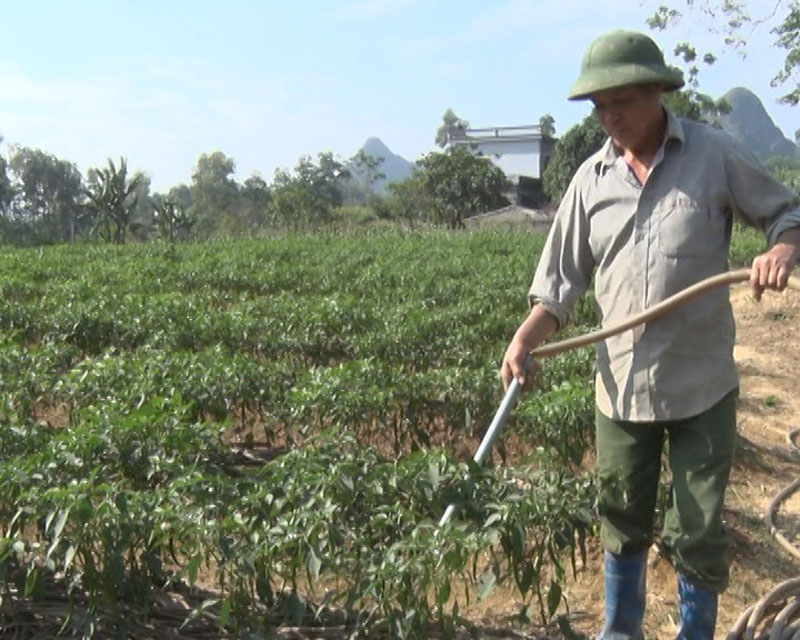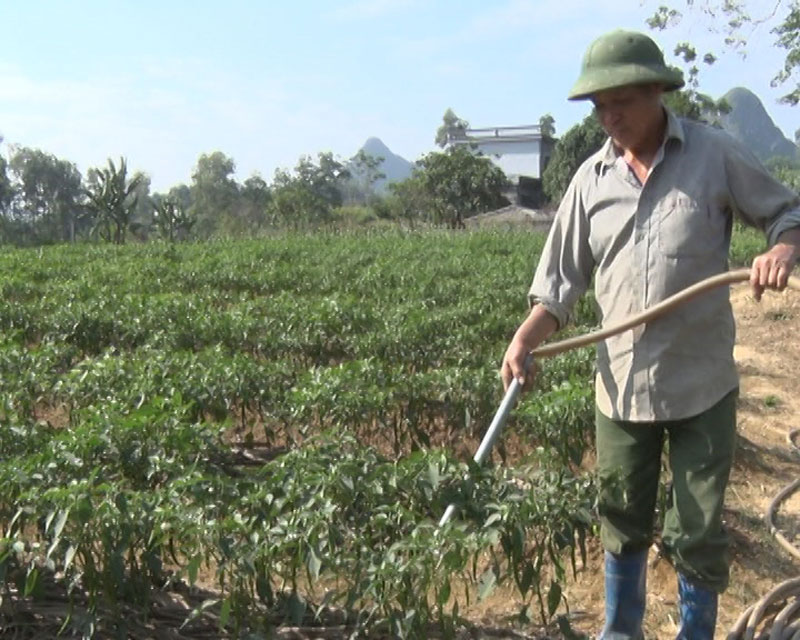
HBO – Agriculture production toward value chain is one of the breakthroughs in restructuring the agriculture sector today.
Lac Thuy district has helped local farmers by connecting them with enterprises, instead of letting them struggle themselves in the market.
Enterprises are responsible for providing materials, technical assistance and buying agricultural products of local farmers, while farmers only focus on production. The connectivity models help to ensure product quality and origin tracing.
In August 2016, An Lac commune signed a contract with Vietnam Chilli Co. Ltd. on growing hybrid chilli for export on 3.5 hectares of land. The pilot project involved 19 farming households in An Phu and Loc Thanh hamlets. They used chilli variety 7 (a Chinese hybrid chilly), which produces fruits in two months of growth. This was the first time local farmers had grown chilli crop. They followed standardised cultivating procedure, thus resulting in high yield and quality with an average productivity of between 1.2 tonnes and 1.5 tonnes of chilli per Vietnamese acre (360 sq.m). The Vietnam Chilli Company bought all chilli produced by local farmers at prices range from 5,000 VND to 10,000 VND per kg, much lucrative than rice and maize. Farmers could earn between 200 million VND - 250 million VND per hectare of chilli.
Following the successful pilot model, the chilli growing area was expanded to 20 hectares with the involvement of eight out of 15 communes in the Lac Thuy. The district signed contract with the Mien Bac Green Agriculture JSC in Kim Dong, Ha Nam province.
The business-linked model on chilli growing for export An Lac commune, Lac Thuy district has high economic value.
Two other value chain-based projects are implemented in Lac Thuy district, including chicken raising and vegetable cultivation. The project on raising 20,000 local chicken in Dong Tam and Phu Thanh communes, involving 20 households, meanwhile the other on concentrated safe vegetable production is carried out in Dong Tam, Co Nghia and Lac Long communes.
Attention was also paid on luring investment in the district’s rural areas. A number of firms invested in safe vegetable production and herbal plant cultivation in late 2016 and early 2017 under the connectivity model toward chain value, including the Lac Thuy clean agriculture company, Vietnam Chilli Company, and Sinh Loc Vocational training Company.
Besides, other companies such as the Mien Bac Green Agriculture JSC and Vietnam Chilli Company want to participate in connectivity models on chilli and pumpkin production for export.
Quach Tat Liem, Chairman of the Lac Thuy district People’s Committee, said the district targets to raise local income per capita to over 34.5 million VND at the end of 2017.
Therefore, the district has instructed its communes to actively shift economic and agricultural production structure toward high-economic goods production, while promoting human resources training; building appropriate production models, and developing connectivity models.
Incentives should be offered to encourage the connection among managers, farmers, firms and consumers in tandem with protecting the environment, establish cooperatives and farms, invest in agriculture and rural development, form large-scale fields, and use agricultural machinery to reduce post-harvest loss.
In addition, focus should be also put on providing vocational training for rural labourers, promoting industrialisation in rural areas, creating jobs and shift rural labour structure.
According to data from the Hoa Binh Provincial Party Committee, the industrial production index for the first six months of 2025 is estimated to have increased by 20% compared to the same period last year. This marks the highest year-on-year growth rate for this period since 2020.
In the first six months of 2025, Hoa Binh province’s export turnover was estimated at 1.145 billion USD, marking an 18.11% increase compared to the same period in 2024. Import turnover was estimated at $ 804 million, a 17.15% increase, which helped the province maintain a positive trade balance.
The lives of the ethnic minority farmers in Tan Lac district have gradually improved thanks to the new directions in agricultural production. This is a testament to the collective strength fostered through the professional associations and groups implemented by various levels of the district’s Farmers’ Union.
With the motto the "product quality comes first,” after nearly one year of establishment and operation, Muong village’s Clean Food Agricultural and Commercial Cooperative, located in Cau Hamlet, Hung Son Commune (Kim Boi district), has launched reputable, high-quality agricultural products to the market that are well-received by consumers. The products such as Muong village’s pork sausage, salt-cured chicken, and salt-cured pork hocks have gradually carved out a place in the market and they are on the path to obtaining the OCOP certification.
In the past, the phrase "bumper harvest, rock-bottom prices" was a familiar refrain for Vietnamese farmers engaged in fragmented, small-scale agriculture. But today, a new spirit is emerging across rural areas of Hoa Binh province - one of collaboration, organisation, and collective economic models that provide a stable foundation for production.
Maintaining growing area codes and packing facility codes in accordance with regulations is a mandatory requirement for agricultural products to be eligible for export. Recently, the Department of Agriculture and Environment of Hoa Binh province has intensified technical supervision of designated farming areas and packing facilities to safeguard the "green passport" that enables its products to access international markets.



